My city: home (1)
Bochum: Steel Heartbeats
Bochum, I come from you. There aren’t many who can say that. Annika Engelbert can. A story about culture, education and lots of love in the Ruhr, visualized by Ronald Krentz.
A ship from the British Empire. A captain singing karaoke. Spirits at dawn. Martin Schacht and Ken Schluchtmann travel down the muddy river Ayeyarwaddy from north to south towards Mandalay.
Burma has mastered the art of being either dusty or muddy like no other country. Sometimes it’s even both at once. The soil switches abruptly between the two states, regardless of whether it’s rainy season or dry season, north or south, city or countryside. It’s the rebirth of dust from mud and from dust again, a samsara of grime. No sooner does the dust come into contact with water than it transforms into a viscous sludge with a distinctive deep red tone.
People can use the condition and colour of your shoes and feet to tell if you’ve been to Burma.
‘When in Rome,’ goes the saying, and the Burmese wear sandals to all occasions, even gala dinners. As a European, however, you sometimes end up feeling naked, or you’re worried about stubbing your toe, which isn’t entirely unjustified in a land full of potholes and open sewers, into which it’s easy to stumble carelessly. Moreover, it’s cold in winter – in northern Burma temperatures can reach freezing. It’s no climate for flip-flops.
Our journey to northern Burma, where we’ll pick up a steamboat back down to Mandalay, will be the last for a pair of navy blue Prada slip-on shoes that have served me well for more than five years, achieving an advanced state of disintegration in the process. Mandalay, one of the dustiest cities in the world, is a fatal environment for shoes, especially suede ones… but first, the mountains.
The famous Gokteik viaduct is an audacious miracle of a structure, and a train journey is a prêt-à-porter show of Burmese art.
We definitely want to cross the bridge, which for decades was closed to foreigners and where photography was forbidden due to its strategic importance. The viaduct, completed in 1900, is 700 metres long, and was once the second highest bridge in the world. It has survived for more than a hundred years virtually unmaintained. A new bridge built by the government a few years ago across the valley was promptly swept away during the first rainy season. You can gaze down in wonder at the remnants of it as you cross the old bridge above.
Buying a train ticket in Burma is an interesting process. As a foreigner you need a passport to do so, and its number will be painstakingly noted down in all sorts of lists and books. Once the whole country was reminiscent of a tropical East Germany, and the bureaucracy still is. The train journey itself can’t be beaten on price, and it’s an experience that – especially in second class – gives new meaning to the term ‘cattle class’. This is where the locals sit, mostly cross-legged, on the benches, with bags of all kinds full of goods for their villages.
Men and women push their way down the aisles before we depart, then at every station, balancing enormous trays on their heads and selling every imaginable kind of snack. The small quail eggs wrapped up in plastic bags are genuinely delicious, and you can get them everywhere, although I’ve never actually seen a quail in Burma. Somewhere or other there must be a giant, clandestine quail farm.
The train offers plenty of opportunity to study Burmese winter fashions, which possess a certain chicness all their own that has absolutely nothing to do with our Western conception of style. Burmese women are masters of pattern mixing, and their taste in colour is very different: they’re quite happy to combine soft, fifties-style pastels with traditional patterns. They like to team their longyis with lots of layers of outerwear, hats shaped like comic-book animals and a colour-coordinated child in their arms. They might also wear elements of their mountain tribe’s traditional dress, with customised patterns painted onto their faces in thanaka paste. Sometimes they wind a sort of towel-like checked fabric with a fringe around their heads like a turban – all in all it’s an ethnic-wear-meets-comic-book look that would also work well in big Western cities.
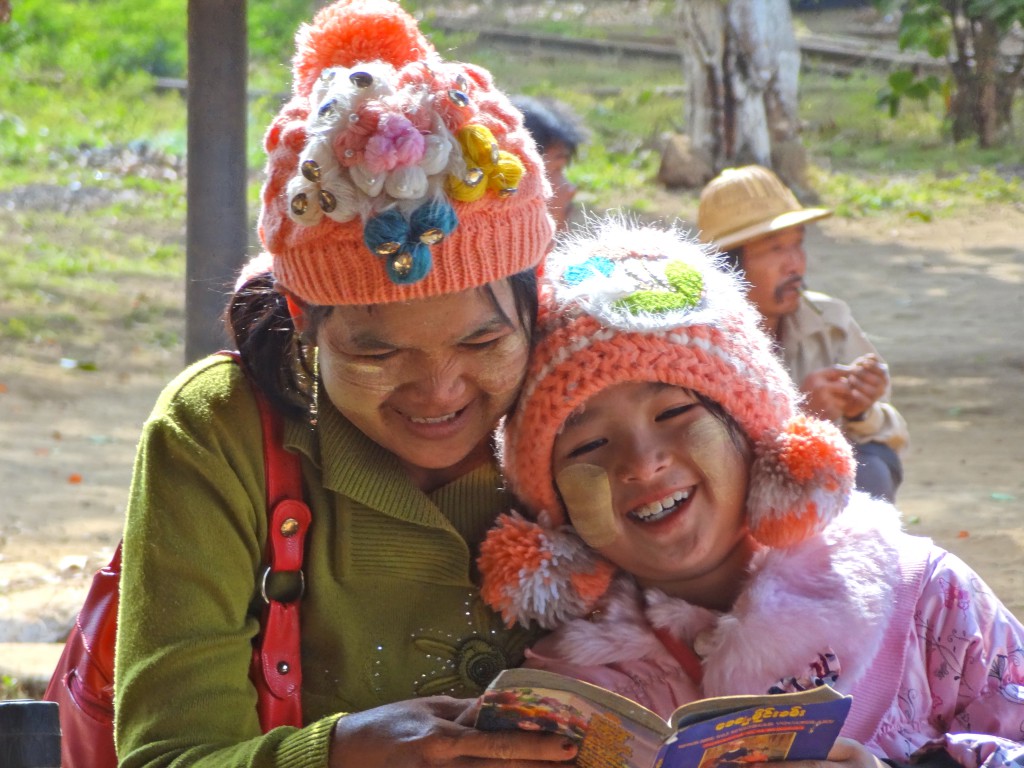
After about two hours of being jolted around – the train carriages were a gift from North Korea, which until not very long ago was the only country that had a friendly relationship with Burma – the train crawls slowly and painfully around a long, leftward curve towards the viaduct, and you can see straight into the ravine.
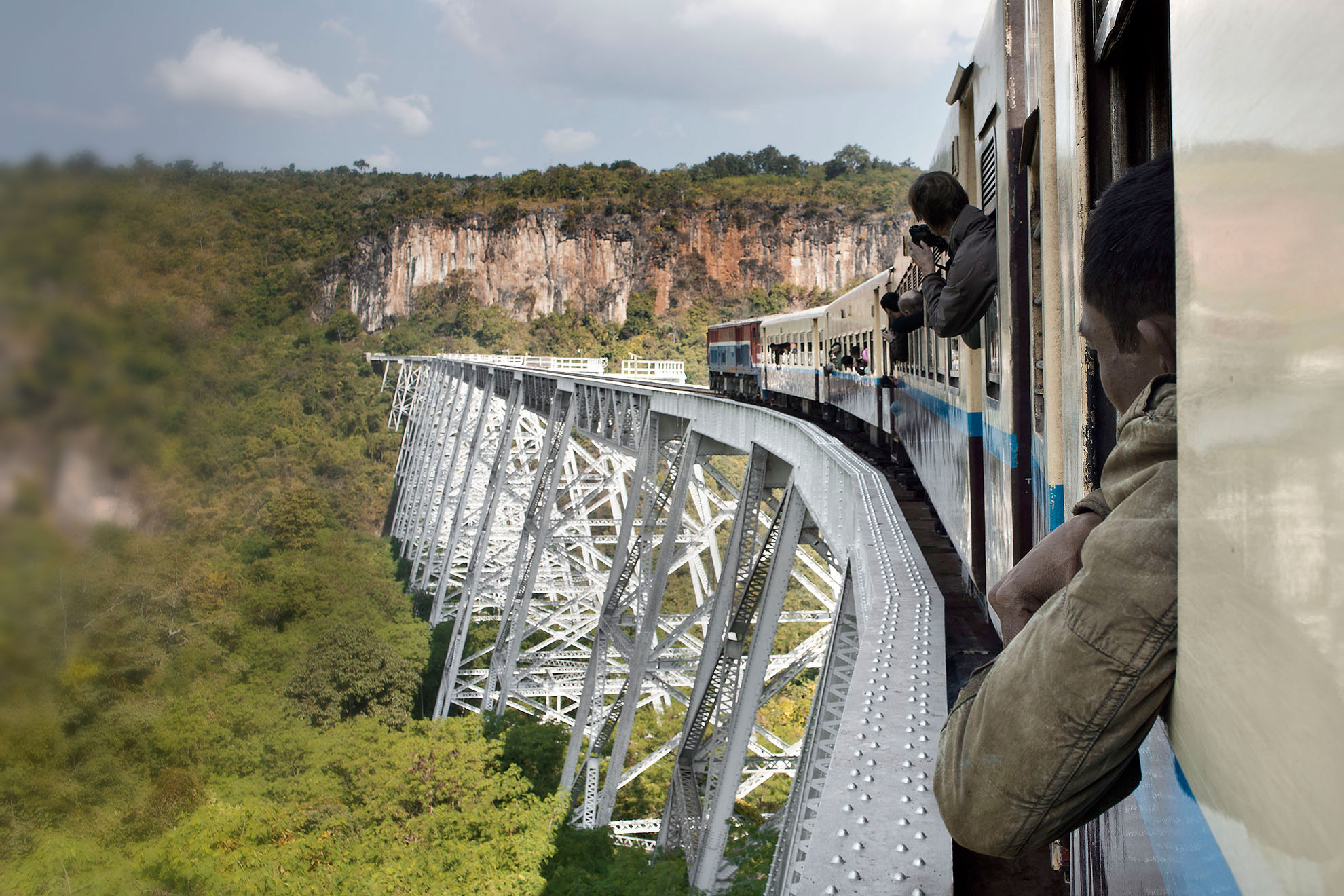
Before it crosses over, the train stops for a few minutes as if pausing for breath. Then we continue, no faster than walking pace.
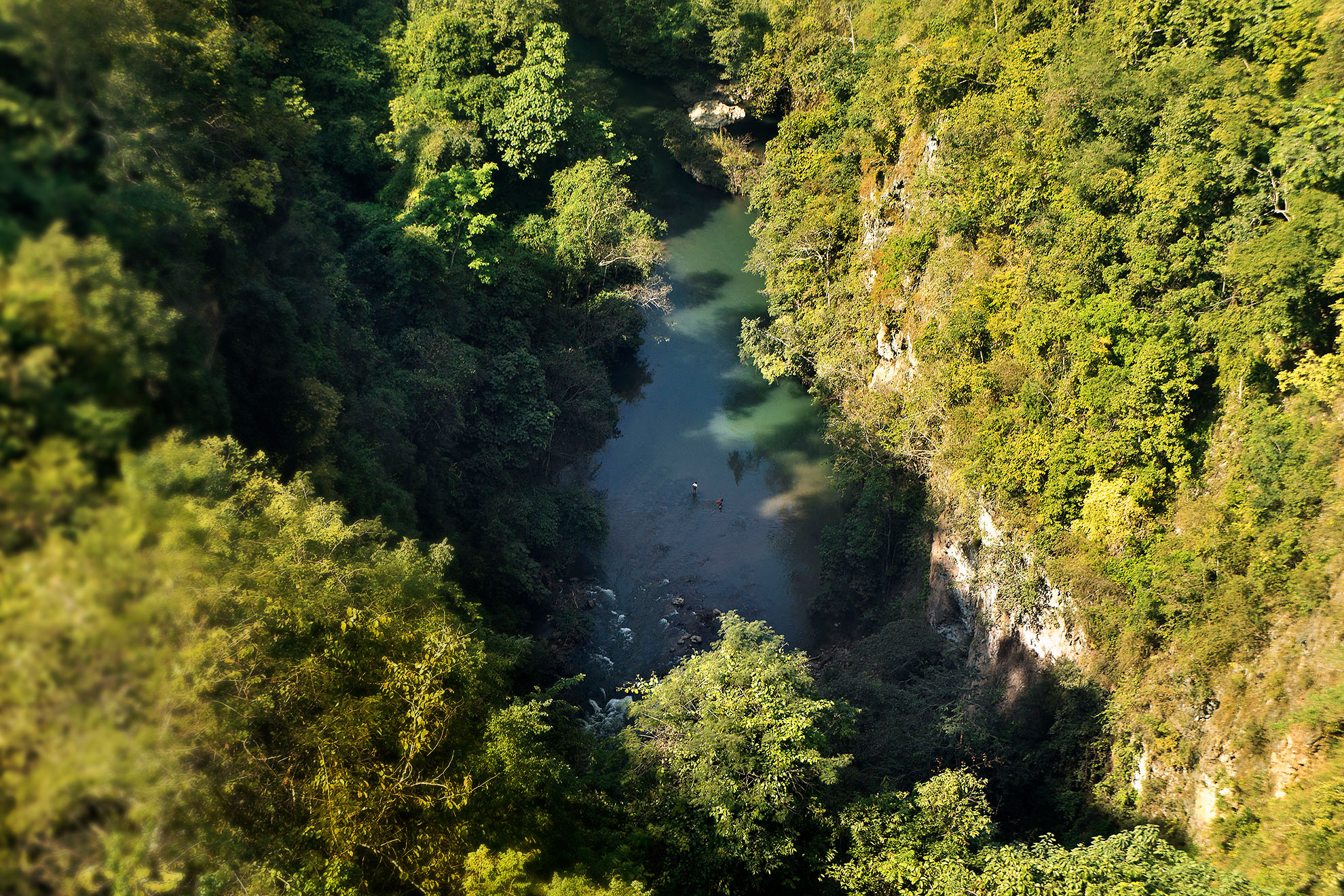
They don’t want to ask too much of the aging, weakened structure. The bridge is single-track, and so narrow that you can look out of the window straight down into a three-hundred-meter-deep abyss.
I think about how a local once told me that the bridge is painted every five years by villagers, who get paid ten dollars a day. It’s a well-paid and highly sought-after job.
At the station after the viaduct we get out, but we don’t want to wait for the train back. There are no taxis or busses, but a friendly signalman takes us to the main road one after the other on his moped and hails a pick-up truck for us. After almost four hours on zigzagging dirt roads we’re back in Pyin Oo Lwin and treating ourselves to an astonishingly good cappuccino and piece of cake in the nice Golden Triangle Café on the main street.
* * *
Buddha is smiling on us: we’re allowed to fly to Bhamo. It’s not currently a restricted area, and this is where we’re planning to board our steamer to Mandalay.
You can actually get around in Burma pretty well, even if at first glance there’s no transportation – just so long as you have no problem jumping aboard the occasional pick-up truck or oxcart. And so long as it doesn’t matter whether you arrive a day earlier or later than planned. You can always work something out with a handful of kyat, if you just slow down a little. It’s only flights that you shouldn’t leave to chance. My last attempt to travel down the Ayeyarwaddy by boat was scuppered by the fact that I couldn’t wait two weeks for a domestic flight, which would have taken me to Bhamo in northern Kachin State.
Back then there was conflicting information, too, about whether foreigners were allowed to travel on the local boat at all, or whether you could only get to Myitkyina and Bhamo by plane. In any case, you’re not allowed to travel out of there by land – or, at least, only with special permission – because the rebels are engaging in skirmishes with the army. Ever since Myanmar suddenly started getting along so well with the USA, the Kachin rebels have been supplied with guns and money by the Chinese.
This time we managed to hunt down plane tickets to Bhamo in advance, and from there it’s a three-day journey to Mandalay by boat. Bhamo itself turns out to be a pleasant surprise, not least thanks to a guide we’ve booked. Generally speaking, a guide is always an advantage if you’ve not got much time and there don’t seem to be any obvious sights around (other than the vibrantly coloured ordination ceremony for child monks that crosses our path). After all, guides know their way about. Our guide Sein Win, a sprightly old man in his late sixties, is a local celebrity.
After forty years of working in his front garden he’s built a functioning helicopter.
This is one of Bhamos’s two tourist attractions, and the only reason it doesn’t get off the ground is that Sein Win can’t afford the right motor.
The other is Bhamos’s best-known attraction, the longest bamboo bridge in the world. It doesn’t really grab me, at least in the abstract. Bridges are a last resort when I can’t think of anything else to do; as far as I’m concerned, even the famous U Bein Bridge in Mandalay is nothing more than a clichéd photo opportunity with rubbish-strewn villages on either side, and the most exciting bridge in the country, the Gokteik, is already behind us. In the hotel ‘Friendship’ the internet actually works for a change, probably thanks to a whole floor full of UN staff, who cruise through the city in white, sparklingly clean four-by-fours. But the internet has nothing to recommend other than the bamboo bridge. Fine.
We reach the bridge shortly before sundown. Once again, I’m pleasantly surprised: it’s not bad for a bridge.
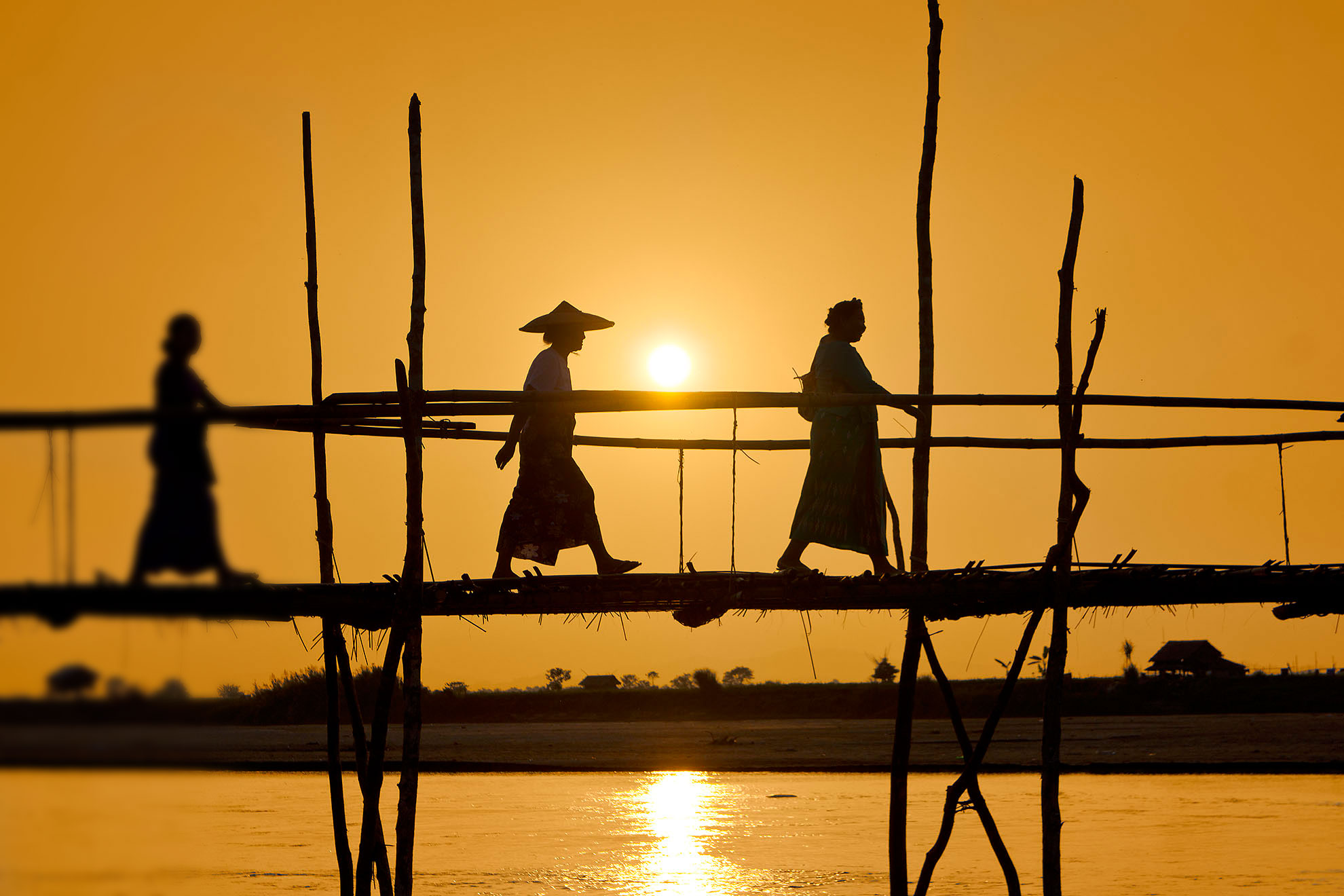
There are people, mopeds, bikes and goats crossing the fragile, five-hundred-metre-long structure, which is swept away by the current every year during the rainy season.
In the first week of December, taking their cue from the shape of the moon, men from the surrounding villages rebuild the bridge. Its completion is celebrated with a party that goes on for several days.
Shortly after sunrise the next morning the atmosphere in the market on the edge of the river is magical. There’s only fruit and vegetables available to buy – as well as some completely useless Chinese trinkets brought from over the border – but the morning light turns everything into cinema.
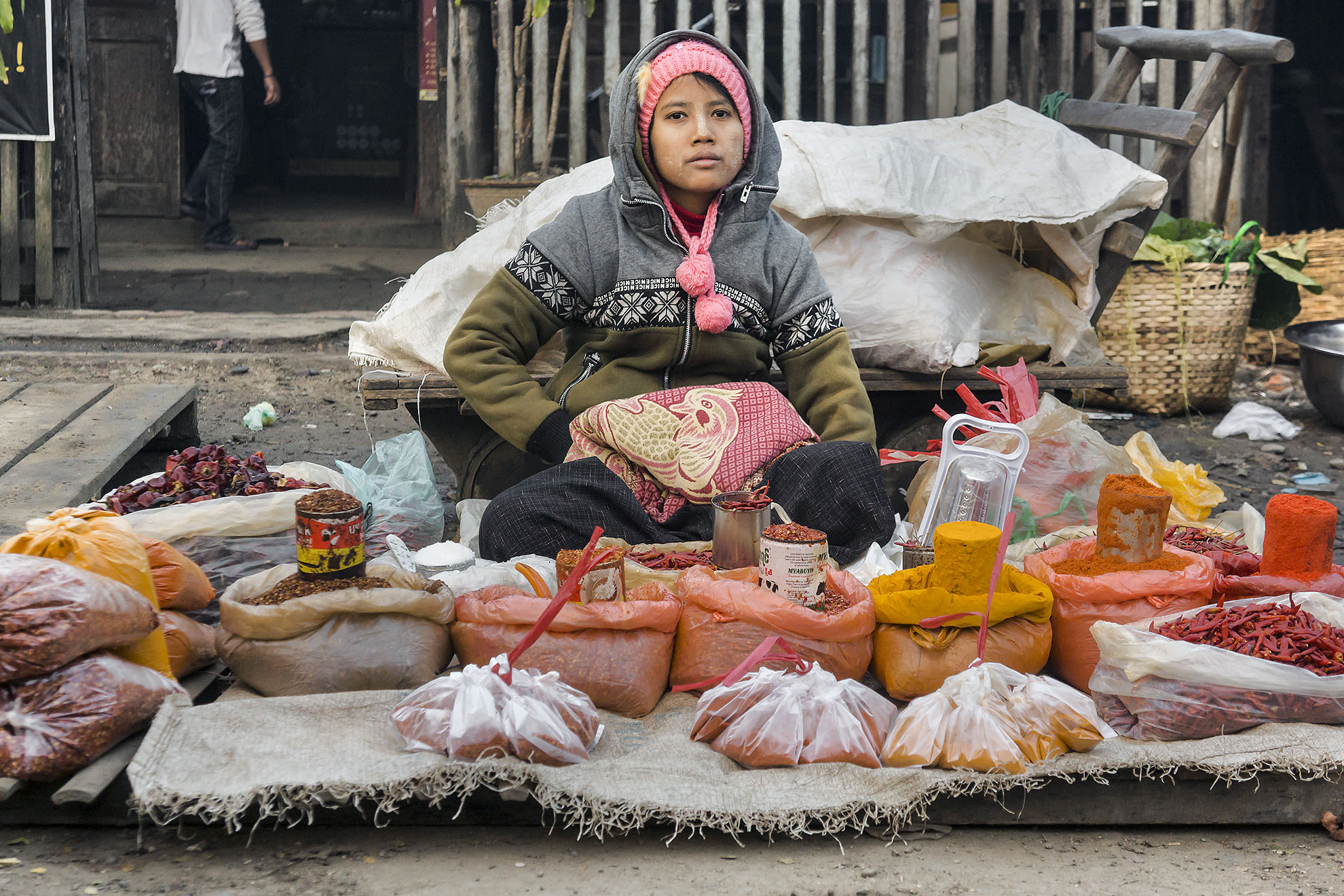
* * *
We board, but our ship doesn’t set off. There’s Burmese hip-hop, a marriage crisis and Grand Royal Whisky, all before daybreak – and then the ghosts appear.
‘Bus?’ my companion asks at reception every now and again.
‘Coming.’
I think the secret of travelling in Asia is making people feel like you’re in their charge. Then they’ll take responsibility and look after you. Today the bus actually forgets us, but in the end it isn’t a problem.
‘Coming back,’ says the woman at reception, pressing parcels of food into our hands. She probably knows what we’re in for.
The Ayeyarwaddy is a long, peaceful and – for extended stretches – very shallow river, up to four hundred metres wide in places. Always Burma’s most important artery, it’s seen powerful empires rise and fall along its banks, most of them leaving only ruins and glittering golden hillside stupas behind them. Here faith inhabits the mountains. Fed by melted snow and ice from the Himalayas and the drenching rain of the monsoons, the river wends its sluggish way through the heart of Burma, finally emerging into the delta by Yangon after more than two thousand kilometres. This was once the largest rice-growing area in the world, one of the things – along with teak and natural resources – that made Burma so coveted by the British Empire.
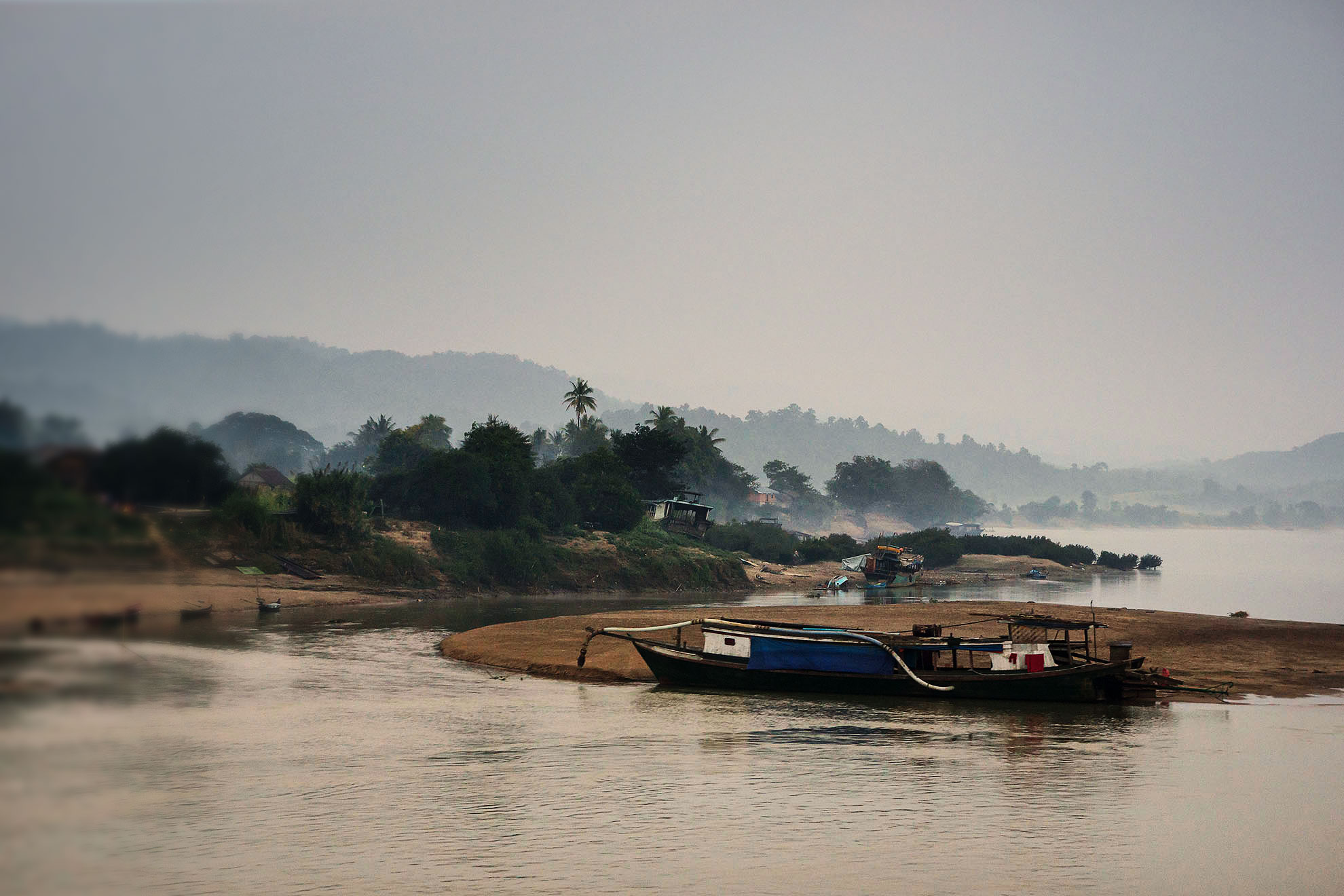
For the British, the Ayeyarwaddy – or Irrawaddy, as it was then known – was the road to Mandalay.
They sent their fleets along it to capture the country, and later it was home to the legendary Irrawaddy Flotilla, the largest river fleet on earth, which met its end in the confusion of the Second World War. More than two hundred ships were sunk outside Katha, to prevent them falling into the hands of the Japanese. The former head office of the Irrawaddy Flotilla Company in Yangon’s Pansodan Road, with its façade of Doric columns, is still one of the former capital city’s most glorious buildings. Remnants of the fleet are still serving on Burma’s rivers almost seventy years after the end of the war – like the three-level steamboat that’s going to take us to Mandalay, for instance.
Our floating coffin must have seen a few things in its time.
Our bus does come at some point, but in the end the departure of our ship is delayed by a day anyway, and we spend about half a day sitting on small stools on the dusty banks. There’s no need to panic – people bring us cold and warm drinks, and we still have the food parcels.
The passengers without cabins travel into the city, back to the Hotel ‘Friendship’. We, on the other hand, can check in straight away. A thin foam mattress, a porthole, a chair, a naked lightbulb – the cabin is a simple affair. The night-table drawer with the enormous cockroach is held permanently closed with gaffer tape.
In the last light of the setting sun, workers throw sacks over their shoulders as if the fifty kilos of rice inside were nothing. Sunburnt, sinewy and barefoot, their upper bodies naked, they keep their balance across narrow planks and sling their burden into the belly of the ship. They hardly have time to unload one of the rattling pick-up trucks before the next one arrives.
They’ll keep doing so by floodlight until dawn, their movements accompanied by the deafening Burmese hip-hop blaring out of speakers as tall as them. Those not actively working squat down in the dust and drink Mandalay beer – for ten bottle caps you get a promotional T-shirt – or they while away the time with karaoke, a multi-voice cacophony that sits uneasily with the starlit night. But in this sense the Burmese are no different to people in other Asian countries – they like it loud.
Noise drives away the spirits.
At daybreak they appear. We’re sitting with a bottle of Grand Royal Whisky on the side of the steamboat facing away from the bank and the noise, gazing at an increasingly dense white wall. Swathes of fog rise up from the water, until you can’t even see your hand in front of your face. That shadow – is it a large bird? That lapping sound – a rowboat? The din of the music and the generators are just an echo here, and the glass we set down on the railing is rattling a little in time to the rhythm.
The crew have locked themselves in a cabin with a few bottles of whiskey and a metal bucket full of ice cubes. They’re singing karaoke. The captain’s wife tries to open the door with a lock pick. She clearly can’t stand it when the men drink. Silent and dogged, she tinkers with the lock for almost an hour, apparently undisturbed by our presence. Eventually the door flies open, and after a loud argument the bottles are flung into the water. The party is over.
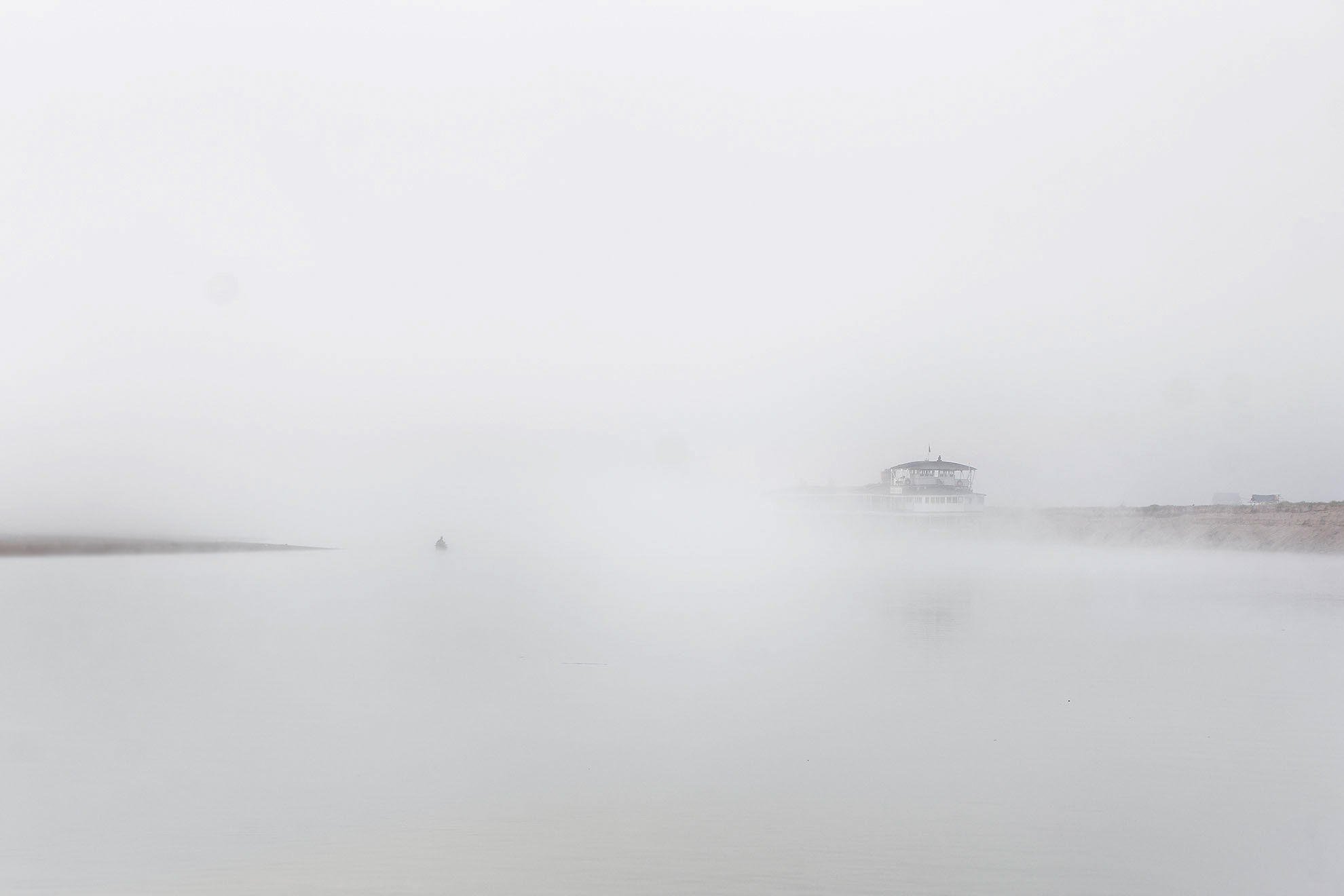
A wooden fishing boat disappears into the fog and heads over towards a sandbank. Whole families live on these temporary islands during the dry season, digging up the gravel from the river bed to sell on to construction companies.
As broad and powerful as the Ayeyarwaddy is, for eight months of the year it’s also very shallow along much of its length. Sandbanks and rocks are treacherous for ships, which for most goods and passengers are still the only way of travelling across the country. Our ship can only depart in the morning once the sun has dispelled the haze. Two men are standing on the bow and poking at the mud with long bamboo sticks, checking the water level. Once it reaches one fifty it’s enough. That’s the minimum the cargo ships and ferries need beneath their keel.
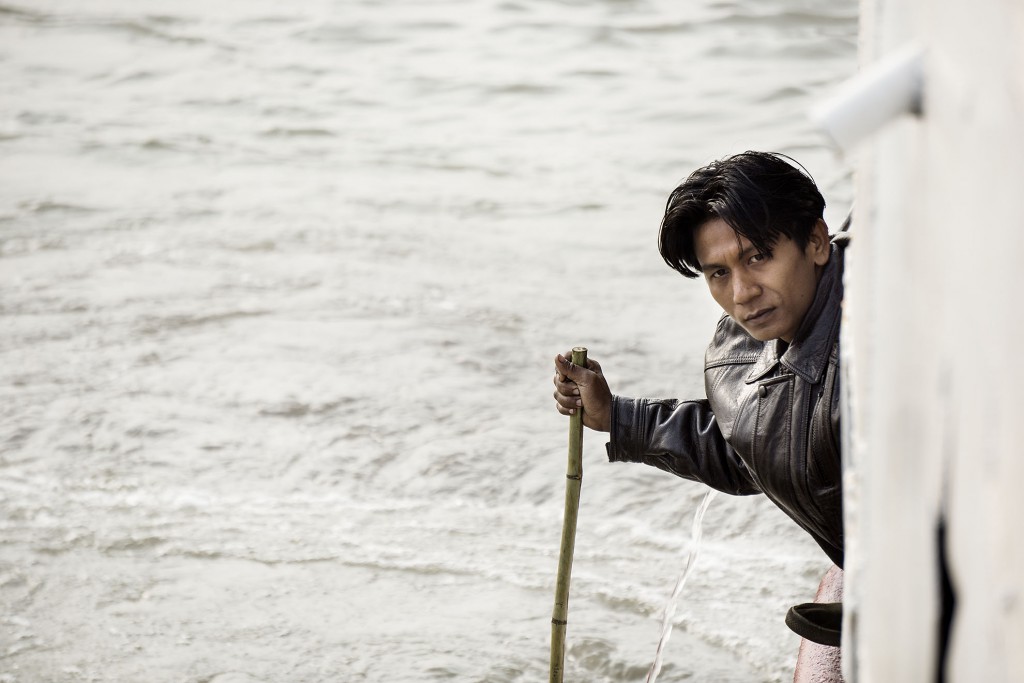
If the boat runs aground anyway, it just manoeuvres back and forth until it’s gone a few hundred metres further. Only the rafts made of teak logs or bamboo can make it through with less water, and are heading southwards at a walking pace.
* * *
It’s four days to Mandalay. Along the river you start to lose track of time. Then again, what’s the hurry?
At some point we’ll simply arrive somewhere, and if we can’t go any further by boat we’ll find some other means of transport. I’m not worried about that. I’m soon seized by a feeling of lethargy, as the landscape scrolls past like a film: pagodas, rocks, water, herons taking flight. Buddha’s message is blaring out from the loudspeakers of an approaching ship. Thankfully I don’t really have to move much.
‘On the road to Mandalay, where the flyin‘ fishes play…’.
Maybe Rudyard Kipling was thinking in his famous poem of the rare Ayeyarwaddy dolphins, which apparently help out the local fishermen with their catch, presumably working on commission. By the time someone yells out ‘dolphin!’, I’ve obviously already missed it. It’s submerged in the unfathomably muddy waters.
Just like hundreds of years ago, women are washing clothes, naked children are playing in the mud, and huts disappear beneath the huge trees on the riverbanks. It’s only when we dock that chaos breaks loose. Women with baskets full of lunchboxes, snacks and drinks spring aboard, hands full of fruit reach out towards the travellers, children wave, various sacks and crates are carried on and off. It’s only a few steps from the jetty into everyday life. A monastery, a small school – a shop, if you’re lucky – all these riverside villages are like that. Dust-coloured dogs snooze in the shadows. Those who have business to attend to bustle quickly off the boat. It can take a while until the next one comes. As soon as we set off again the whole place is still and lifeless once more.
My shoes are holding up pretty well, though by now they’re two-tone. The red dust has settled in the seams and creases, creating an interesting and fashionable colour gradient. They have a water stain too, because there’s always a few centimetres of water on the floor in the on-board toilet. It comes from the flushing mechanism, which sprays water everywhere like a sprinkler system. Still, at least it’s clean water. There are a few wooden blocks you can balance on if you want dry feet while you’re on the squat toilet. There’s no shower, of course, and I decide against washing myself in a barrel.
In the open lower deck there’s a kind of restaurant with an open fire and a large, battered pot for cooking rice. There’s also an assortment of beer, whiskey, crackers and an incredibly sweet coffee three-in-one mix. The attendants are sleeping behind the bar or around the stove, thickly swaddled in plush Chinese duvets with a flowery pattern.
The local guests – and a German couple from the blog ‘Silverpacker’, aimed at older travellers – have settled down between decks. There are numbered sleeping places marked out on the metal floor, and in the morning the deck is cold, damp and slippery with dew. The Silverpacker couple seem to know absolutely everything, and have brought self-inflating sleeping mats, all sorts of functional clothes and probably also night vision goggles and a mobile water treatment unit.
I find our acquaintance distinctly informative, and absorb information about remote parts of the world that would take forever to research by myself.
If war broke out tomorrow, I’d latch on to them immediately and abandon my travelling companion to his fate.
My photographer Ken seems to sense this. They’re a thorn in his side. ‘A single European ruins the picture,’ he likes to say, and he hates anybody who spoils his pictures as a matter of principle. He breathes a sigh of relief when we reach Katha – where George Orwell once served as an officer in the English army – and the Silverpackers disembark in the middle of the night (thanks to the delay) and without a hotel booking. There’s no need to worry about them.
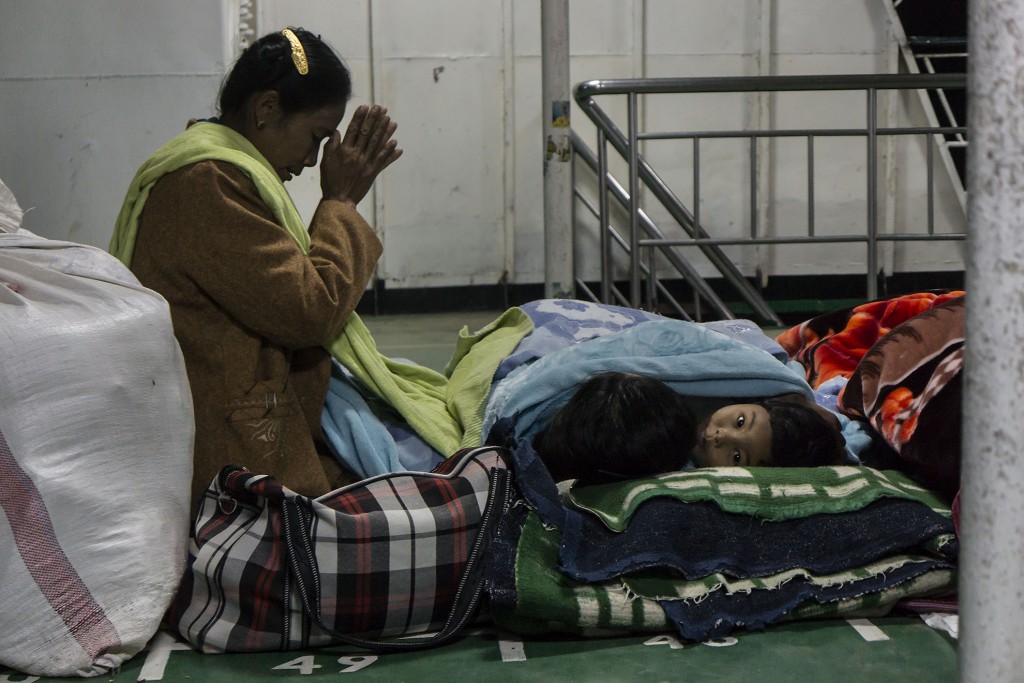
The other passengers fit perfectly into our scenario. We’re given them codenames: the spy, the general and the lunatic. We don’t know whether ‘the spy’ is just pretending to be mysterious, but a few years ago I would have sworn that the government had ordered him to keep an eye on us. He chews betel and starts drinking before midday, and his whole demeanour is like a lean question mark with claw-like feet. He speaks surprisingly good English, and he sticks to Ken, who struck up a conversation with him, like glue. He and another group of men urge Ken into handing round a bottle of Grand Royal Whisky. I, however, have ensconced myself behind a book and a pair of sunglasses on the upper deck. I don’t think I’d survive listening to the drunken ramblings of the locals for three days. People greet me respectfully – apparently the book makes me seem like an intellectual.
I’m more interested in the two soldiers. ‘The general’ is a sunburnt Nepalese man, about one and half metres square, who seems to have eyes on the back of his head. He’s accompanied by a younger, silent soldier, who stares into nothingness with wide-open eyes as if seeing terrible visions.
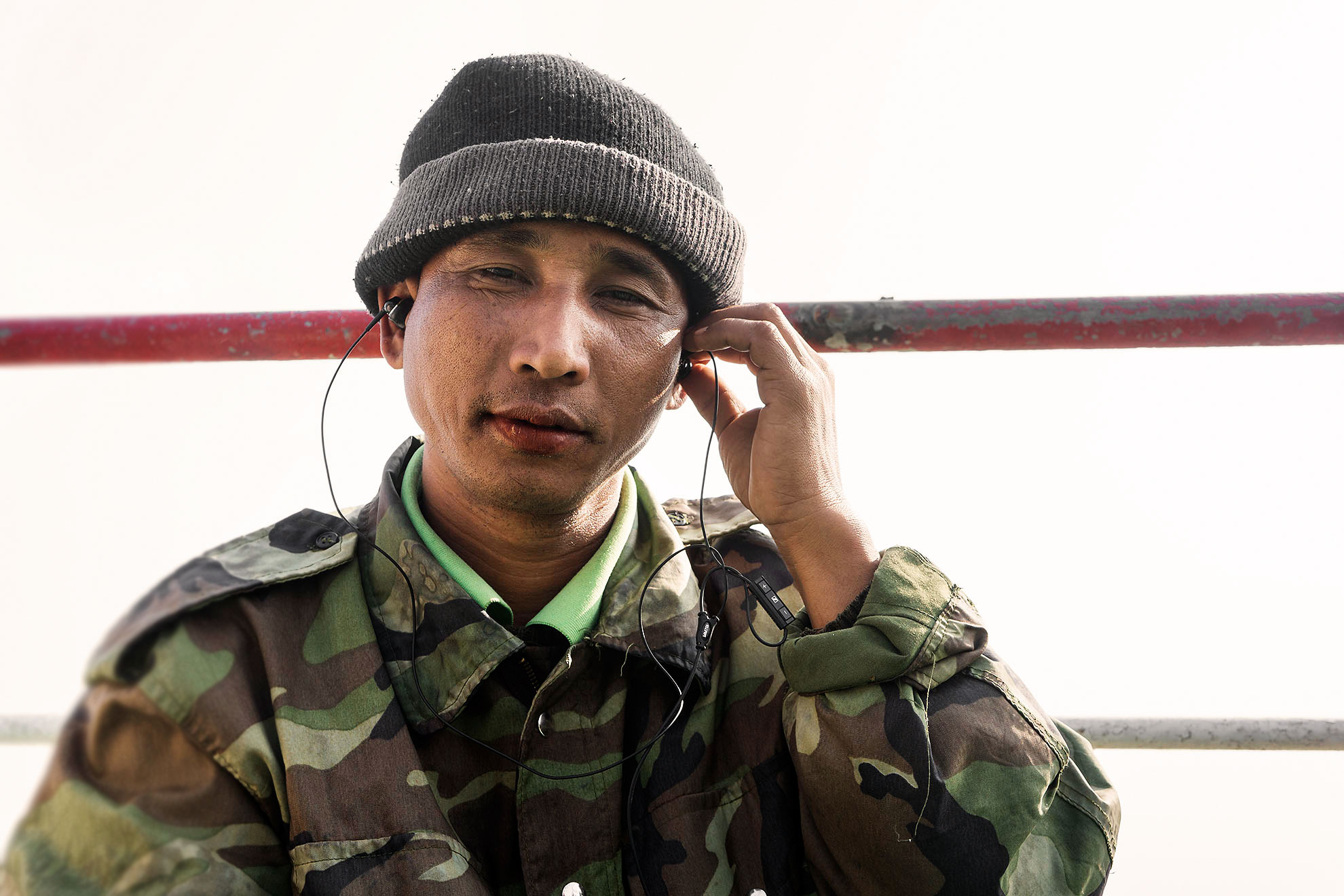
He only allows himself to be drawn out of his catatonic state for a few minutes by Ken’s camera.
When Ken lends him his headphones too, he’s completely enraptured for several minutes.
We discover that ‘the lunatic’ was traumatised in combat and that ‘the general’ is taking him for psychological treatment in Mandalay. ‘The general’ may look like a cuddly teddy bear in uniform, his pistol in his belt, but he’s certainly a force to be reckoned with. You wouldn’t want to bump into him on a dark night if you weren’t on his good side. We try to imagine what could have traumatised ‘the lunatic’ – certainly something to do with the rebels, who we’ve heard have recently been burning whole villages to the ground – but we don’t want to know the details. There it is again, the feeling that’s always fascinated me about Burma: sometimes you just can’t work out a situation and its players.
Maybe it’s all completely harmless – maybe not.
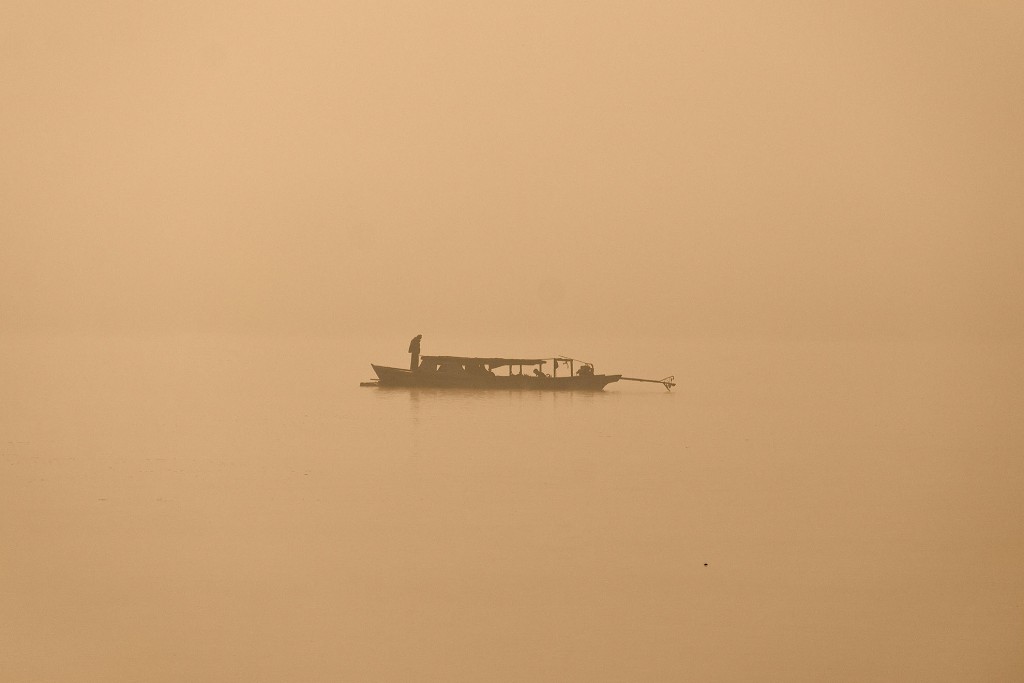
After an initial journey through spectacular gorges, the river becomes increasingly slow and broad, the temperature warms up and everything on board falls into a routine. You nod or exchange a few words with ‘the spy’ or ‘the general’. Ken’s drinking buddies feed us pistachios that they’ve bought in huge numbers when we docked at a village not marked on the map. The whole deck is covered in shells.
Soon the wind will have whisked them away.
We’re now eighteen hours behind schedule, but I built in an extra day as a buffer. Suddenly, however, everything goes very quickly. One last bridge, then Mandalay emerges from behind a bend in the river. We dock somewhere along the bank – why not the jetty, God only knows – and teeter across wooden planks onto dry land. There’s one final ascent up the moist, slimy embankment, then we’re standing in the dust once more, joyfully awaited by a horde of rickshaw drivers.
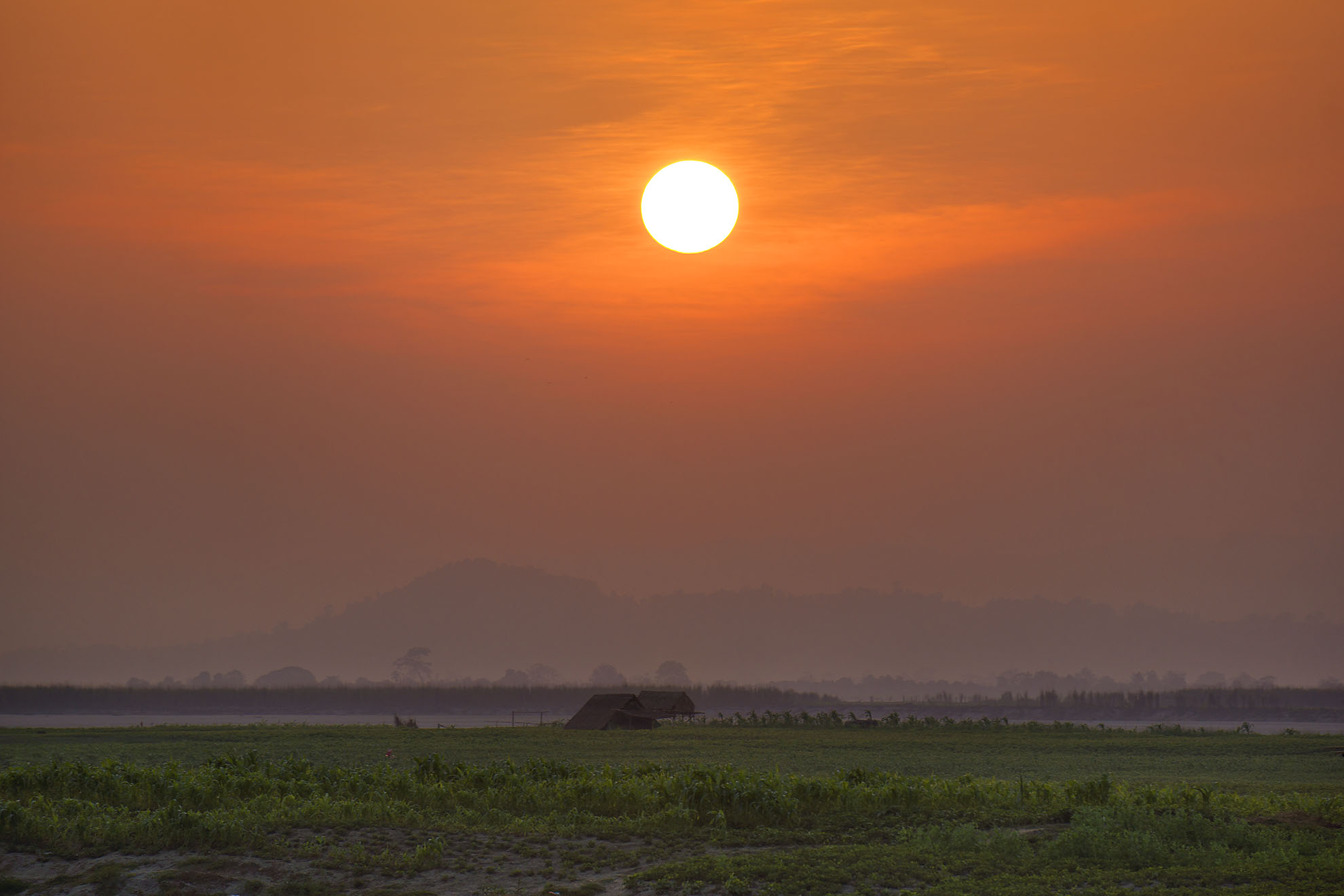
We’ve just missed our flight to Bangkok, of course – maybe by an hour – but it doesn’t matter. Getting upset isn’t going to help. A few metres further on there’s a stupa. I put my bag down and rummage around until I find my flip-flops.
I almost feel sorry for them, my trusty shoes, when I see them sitting there so alone in front of the little pagoda, and I cast a final backward glance as the rickshaw departs. So long!, I think. Someone or other will want you.
* * *
Translation by Caroline Waight
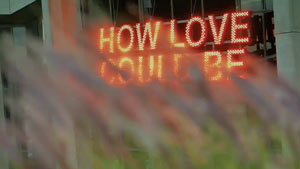
Bochum, I come from you. There aren’t many who can say that. Annika Engelbert can. A story about culture, education and lots of love in the Ruhr, visualized by Ronald Krentz.
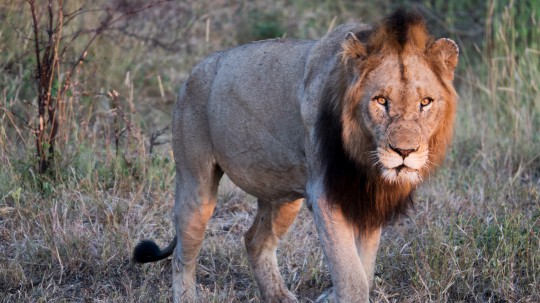
Johannes Klaus goes travelling in South Africa’s Garden of Eden, Kruger National Park. But it’s no paradise: man is a wild and deadly animal.
Ruanda Mister Guhonda und die letzten GorillasElfenbeinküste Die GeisterstadtUganda The Long Road to WaterKongo Crossing CongoSouth Africa: Kruger NP The Big FiveSomalia Welcome to Somalia
USA: Florida 100 miles on the tracks of the CalusaUSA Arm, aber frei – als Hobo durch AmerikaBrasilien Rio de JaneiroArgentinien Aconcagua, 6962 MeterPeru Zwischen Himmel und ErdeUSA: Utah WestworldKuba Drüben, in der anderen WeltKaribik TraumschiffMexiko Comeback mit Backpack in MexikoUSA: Alaska Big RiverNicaragua The Magic of the Corn IslandsUSA: Alaska Alone in the WildernessUSA: Colorado Rocky Mountain High
Antarctic Happy Antarctica
Iran Hochzeit im IranChina Urlaub im ÜberwachungsstaatKatar Fata Morgana Allgäu Orient RallyeMongolei Gekritzel im Sand gegen die große EinsamkeitSyrien Willkommen in SyrienUsbekistan Ein Meer aus SandIndonesien Meine Tage als BuleJordanien JungeBurma Nachtzug nach BaganKirgisistan Die Flügel des MenschenBurma Goldene ZeitenRussland Couchsurfing in RussiaThailand Der Pfad der ErleuchtungAfghanistan KabulChina K2Pakistan Hitchhiking Through Pakistan On the Road of LifePhilippinen Me, Love and Other CatastrophesIran Kids of TehranBangladesh Life and Death in the Empire of the TigerIran Couchsurfing in IranBurma Road to MandalayVietnam Lost in Vietnam
Spanien Ungezähmte BergeFrankreich Yoga und SurfenGermany Ein Esel zum PferdestehlenAustria Der Geschmack des WaldesGermany Vier Räder, Küche, BadFinnland Sehnsucht nach SchneeGermany Mehr Pott geht nichtAustria Mach mal langsamFinnland Hoch in den NordenRumänien In RuinenGermany Grenzgänge durch BrandenburgGermany Towards WinterGermany Das blaue ParadiesSchweiz Zur grünen StundeNorwegen The Rest is Silence Germany ZauberlandSpanien Mrs. Müller Drops OutNorwegen Ultimate FreedomSpanien Into the Heart of the PyreneesFinnland Wandering CosmosGermany The Bundesliga village Germany Under The DomePoland Warszawa rzucająca na kolana On the Road of LifeGermany Munich: Oh well, I live here. So?Germany Jena: Next Stop ParadiseGermany Bochum: Steel HeartbeatsTürkei Arrival in Istanbul Italy Dear Dolomites, I'm BackTürkei Floodlights in the ForestCroatia Ambuscade at the BorderGermany The Bavarian OlympicsAustria Across (Goat) CountryLatvia Somewhere up thereGermany The Big GoalGermany My Loveletter to LangeoogGermany The End of a Journey
Auf der Rückseite des GlobusNew Zealand Speed Dating with New Zealand
Welt Six Pairs of Shoes
Germany Ein Esel zum PferdestehlenGermany Vier Räder, Küche, Bad Freiheit auf vier RädernChina Urlaub im ÜberwachungsstaatUSA Arm, aber frei – als Hobo durch AmerikaKuba Drüben, in der anderen Welt Auf der Rückseite des GlobusFinnland Hoch in den NordenSyrien Willkommen in SyrienUsbekistan Ein Meer aus SandElfenbeinküste Die GeisterstadtBurma Goldene ZeitenRussland Couchsurfing in RussiaGermany Das blaue ParadiesSchweiz Zur grünen StundeNicaragua The Magic of the Corn IslandsKongo Crossing CongoNorwegen Ultimate FreedomSpanien Into the Heart of the Pyrenees On the Road of LifePhilippinen Me, Love and Other CatastrophesTürkei Arrival in Istanbul Türkei Floodlights in the ForestCroatia Ambuscade at the BorderAustria Across (Goat) CountryGermany The Big GoalNew Zealand Speed Dating with New ZealandAntarctic Happy AntarcticaBurma Road to MandalayVietnam Lost in Vietnam
Spanien Ungezähmte BergeGrönland Gefangen im EisIran Hochzeit im IranUSA: Florida 100 miles on the tracks of the CalusaBrasilien Rio de JaneiroArgentinien Aconcagua, 6962 MeterPeru Zwischen Himmel und ErdeUSA: Utah Westworld Allgäu Orient RallyeFinnland Sehnsucht nach SchneeRuanda Mister Guhonda und die letzten GorillasMongolei Gekritzel im Sand gegen die große EinsamkeitRumänien In RuinenJordanien JungeUSA: Alaska Big RiverUganda The Long Road to WaterAfghanistan KabulNorwegen The Rest is Silence Germany Under The DomeChina K2USA: Alaska Alone in the WildernessPakistan Hitchhiking Through PakistanIran Kids of TehranUSA: Colorado Rocky Mountain HighBangladesh Life and Death in the Empire of the TigerIran Couchsurfing in IranSomalia Welcome to Somalia
Frankreich Yoga und SurfenAustria Der Geschmack des WaldesKatar Fata MorganaKaribik TraumschiffGermany Mehr Pott geht nichtAustria Mach mal langsamIndonesien Meine Tage als BuleGermany Grenzgänge durch BrandenburgBurma Nachtzug nach BaganKirgisistan Die Flügel des MenschenMexiko Comeback mit Backpack in MexikoGermany Towards WinterThailand Der Pfad der ErleuchtungWelt Six Pairs of ShoesGermany ZauberlandSpanien Mrs. Müller Drops OutFinnland Wandering CosmosGermany The Bundesliga village Poland Warszawa rzucająca na kolanaGermany Munich: Oh well, I live here. So?Germany Jena: Next Stop ParadiseGermany Bochum: Steel HeartbeatsItaly Dear Dolomites, I'm BackGermany The Bavarian OlympicsLatvia Somewhere up thereSouth Africa: Kruger NP The Big FiveGermany My Loveletter to LangeoogGermany The End of a Journey
Readers Mail
Tell us what you think
Markus on 26. Januar 2015
Großartig! Danke fürs mitnehmen… jetzt will ich noch dringender dorthin :)
ken on 27. Januar 2015
sehr gerne! es lohnt sich – aber gute schlappen einpacken ;)
Philipp on 26. Januar 2015
Feine Sache! Ganz feine Sache. Liebe Grüße
ken on 27. Januar 2015
vielen dank! es war sehr eindrucksvoll!
May on 26. Januar 2015
A fantastic adventure! Thank you!
ken on 27. Januar 2015
you are welcome! thank you for joining!
Simone on 26. Januar 2015
Diese tagelangen Flussfahrten sind toll. Es ist einfach wunderbar die Landschaft vorbeiziehen zu sehen!
ken on 27. Januar 2015
es war tatsächlich eine der beeindruckendsden schiffsfahrten, die ich erlebt habe. vor allem, weil wir praktisch nur unter einheimischen waren. da lernt man mit händen und füssen zu kommunizieren!
Kristine on 27. Januar 2015
Vielen Dank fürs Mitnehmen auf die Reise!
ken on 27. Januar 2015
es freut uns sehr, dass es dir gefallen hat! viele grüsse!
Susan on 28. Januar 2015
Danke für diesen tollen Bericht!
Die Zugfahrt von Hsipaw nach Pyin Oo Lwin war 2011 auch für uns ein absoluter Traum. Dein Vergleich mit dem Luftholen, bevor der Zug über die Brücke fährt, sehr sehr passend. Ein wunderbares Land mit tollen Menschen, denen wir begegnet sind. Danke fürs Wiedererwachen der Erinnerungen an eine großartige Zeit.
Martin Schacht on 29. Januar 2015
zuerst fand ich pyin oo lwin ein bisschen langweilig, aber ich war jetzt schon ein paar mal da, und ich finde es gewinnt jedes mal…
Claus Vester on 30. Januar 2015
Faszinierend, welche Erinnerungen an eine gemeinsam zurückgelegte Etappe der letztjährigen Burma-Reise aus der Gegenperspektive entstanden. Eine lesenswerte Reportage von einem echten Kenner dieser Region! Toll geschrieben und wunderbare Bilder!
ken on 8. Februar 2015
allerdings hat martin etwas übertrieben, als er schrieb, dass ich euch gehasst habe – korrekt war nur die aussage, dass ein europäer das authentische bild zerstört… ;)
Judith Posner on 31. Januar 2015
Wish I had been there.
ken on 8. Februar 2015
just go for it!
Adele on 31. Januar 2015
Wunderschön! War bestimmt eine tolle Erfahrung. Ich will in den nächsten 1-2 Jahre gerne mal einen ganzen Monat im Heimatland meiner Mama verbringen … <3
ken on 8. Februar 2015
es lohnt – nur schnell, bevor die chinesen das ganze land erobern…
Christian on 2. Februar 2015
Hallo an die Autoren des Blogs. Toll geschrieben und super Bilder… so sollte und muss ein Reiseblog wohl sein…er weckt sofort das Gefühl da sein zu wollen… dahin zu wollen, wegzufahren los zu reisen, ab zu haun…ob mit Schlamm oder ohne.. :-) weiter so… *Ch., 48J.*
ken on 8. Februar 2015
vielen dank für das tolle feedback! es freut uns sehr, wenn wir ein wenig der dortigen atmosphäre transportieren konnten.
Petra on 4. Februar 2015
Danke für den tollen Kurzbericht/Film! Beeindruckend gemacht macht er vor allem große Lust auf eine eigene Reise nach Burma! Vielleicht habe ich ja das große Glück und gewinne die Reise ;-)
ken on 8. Februar 2015
danke ebenfalls! nicht warten, sondern losfahren, bevor alle anderen da waren!
Mandy // Movin'n'Groovin on 8. Februar 2015
Wow, danke für die tollen Bilder und die Geschichte dazu… sehr schön geschrieben, ich notiere Burma auf meine Wunschliste. :)
Wohin verreisen im Februar? - Reiseaufnahmen on 13. Februar 2015
[…] in dieses Land entführen und dich nicht genug davon kriegen lassen. Wenn du gleich dem Link zu dem Storytelling Special von Martin Schacht & Ken Schluchtmann auf Travel Episodes folgst, dann werde ich dich […]
Joni on 15. Februar 2015
überragend! darf ich fragen wie der soundtrack aus dem ersten film-clip heißt? :)
Johannes Klaus on 18. Februar 2015
Hi Joni! Schau mal hier: https://www.youtube.com/watch?v=KENqLM8dI98 :)
Rainer Milzkott on 24. Februar 2015
Das habe ich gern gelesen und die Bilder eingesogen. Dass nichts nach Fahrplan läuft, das hat man als Berliner S-Bahnnutzer immerhin auch schon zu ertragen gelernt. Aber dieser Reisebericht macht mir vor allem deutlich, was für ein Luxuswesen ich doch geworden bin: Über so viel Staub und Schlamm würde ich mich permanent aufregen. Keine ordentliche Toilette auf dem Schiff, furchtbar! Womöglich ist der Whisky gepanscht! Und die Beschreibung des Frühstücks…, nein Danke! Aber das ist ja das Schöne an Reiseberichten, die „Er-Fahrung” sesselgerecht aufbereitet zu bekommen.
Max on 4. März 2015
Wundervolle Episode und fast noch schönere Bilder!
Würde das letzte gern als Screensaver und Vorfreude auf meine Südoastasienreise im Sommer nutzen kann es aber leider nicht kopieren, wäre es möglich mir das Bild zuzusenden? Verwende es nur für private Zwecke keine Sorge ;)
william clydesdale on 14. März 2015
Our son and girlfriend are on a holiday and are just now on the way to Mandalay, we did not know much about Burma and have found your article and photos fascinating.
Thank you very much.
Natalie Axten on 24. März 2015
That’s what I call real design and worth the time spent reading, exploring, travelling with you all! Superb job!
Marc on 14. Mai 2015
Oh man! Toll, super. Ich will auch :)
Sorry, für den kurzen Kommentar, aber ich finds einfach nur toll! :)
Danke!
Myanmar country profile | Som2ny News on 23. November 2015
[…] Travel Episodes – Road to Mandalay […]
Dave on 17. Dezember 2015
Bin selbst vor 2 Jahren durch dieses tolle Land gereist und bin seither infiziert.
Habe unglaubich viele und schöne Erfahrungen und Bilder gemacht.
Plane 2016 wieder für 3 Wochen zurück zu kehren.
Euro Photos sind großartig, was für eine Kamera/Objective habt ihr denn benutzt?
LG
Dave
Dave on 17. Dezember 2015
Hier ein paar Fotos von meiner Reise:
https://www.flickr.com/photos/110605943@N04/albums
Arthur Leidig on 17. Dezember 2015
Frage: Kann ich von Madalay über Meiktila-Kalaw-Taunggyi weiter nach
Mong Ping Kengtung nach Mong-Hpayak bis zur Grenze nach Tachilek Mae Sai
Thailand fahren?
Oder wäre es besser ich fahre von Laos über den Mekong hoch bis Tachilek-
Mae Sai, und dann nach Mandalay? Oder handelt es sich hier um eine Scheiß-
idee?
Danke für eine Antwort.
Mit freundlichem Gruß
Arthur
Michaela on 23. April 2017
Der Bericht ist einfach genial und das Video mit der Gokteik-Eisenbahnbrücke phantastisch. Man glaubt echt gerade im Zug zu sitzen :). Nun vielleicht wird´s ja auch bald was. Myanmar steht schon lange (zuuu lange) auf meiner Reiseziel-Liste!
Howard on 10. Mai 2018
I made exactly the same trip except that I took the train and boat from Mandalay to Bhamo and then the boat all the way back to Mandalay. I stopped off in Kata on the Ayeyarwaddy which is where George Orwell was stationed when he was in the army. His book ‚Burmese Days‘ is worth a read.
And on books about Burma there is a fantastic book (fiction) called ‚The Piano Tuner‘ about a British military guy who has a piano shipped out during his period there – amazing story.
Marc D. on 21. August 2018
Ich war im Winter 2017/18 für 5 Wochen in Myanmar (mit 7 Tagen Overstay) und habe wg. meinem Fernweh, heute endlich diesen schönen Artikel gelesen. Gut finde ich vor allen auch, dass darin vieles so beschrieben wird wie es ist, ohne geschönte Travellerromantik. Mein Weg führte nach 7 Tagen in Yangon mit dem Zug nach Mandalay mit dem letzten Platz im „Sleeper“ der noch zu haben war. Mit Indischer Tablamusik im Restaurantwagen sind wir bei Sonnenuntergang losgefahren. Wirklich, Mandalay ist unglaublich staubig, besonders auf der Strandroad entlang des Irrawaddy, liegt besonders viel Sand.
Auch sind die Entfernungen sehr groß u. man muss aufpassen, nicht in eines der vielen Löcher zu fallen. Ich bin dann mit dem Boot (ca. 10-12 Std.) weiter Richtung Süden nach Bagan (mit riesigen, antiken Pagodenfeld, fantastisch). Dann gings nach 4 Tagen weiter mit dem Kleinbus nach Pyin Oo Lwin und von dort auch mit dem Zug über den Glondike-Viadukt. Auffallend war, das Zugfahrkarten frühestens 2 Tage vor Abfahrt gekauft werden konnten, keinen Tag früher. Dann wieder zurück nach Mandalay u. Yangon mit Silvesterparty rund um die Sule Pagoda. Nach 2 Tagen weiter mit Zug Richtung Süden, Mawlamyine, Ye, Dawei und über Kawthoung weiter nach Thailand. In Myanmar zu reisen ist noch ein echtes Abenteuer, die Guesthouses sind etwas überteuert, das burmesische Essen meistens sehr ölig, Western Breakfast und frisch gebrühter Kaffee sind nur selten zu finden, dafür leckere Früchte u. Essen aus Thailand, China u. Indien. Zugfahrten dauern sehr lange und das Internet über WiFi ist sehr langsam, sofern es überhaupt funktioniert. Habe auch noch nie so oft meinen Pass zeigen müssen wie in Myanmar, glaube aber kaum, dass die Behörden ihr eigenes Bürokratiemonster noch überblicken, denn
alles wird noch auf Papier festgehalten. Der obenst. Reisebericht erinnerte mit an eine TV-Reportage, da ist das Kammerateam 4 Wochen lang, mit der „Myanmar“ den Irrawaddy entlang gefahren, das Schiff ist ein schwimmender „Supermarkt“ mit Marktfrauen, das wochenlang von Dorf zu Dorf fährt. Die Schiffe mit denen auch die Burmesen unterwegs sind, sind auch die einzigen die man sich leisten kann, die anderen, mehrtägigen Bootstouren für Touristen kosten leider um die 5.000-10.000 US-Dollar pro Person. Wunderbares Land mit viel Licht und Schatten, besonders schlimm ist aber das Müllproblem, die Burmesen entsorgen z.B. den gesamten Abfall, aus den offenen Fenstern des fahrenden Zugs.